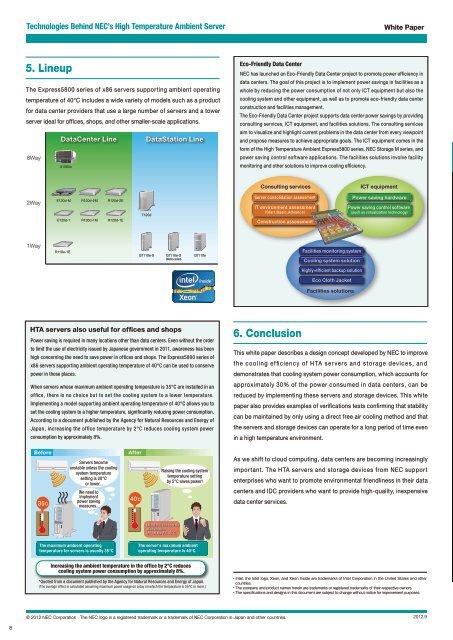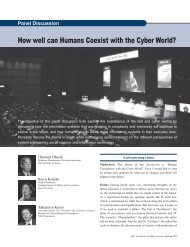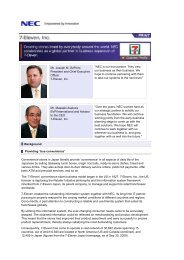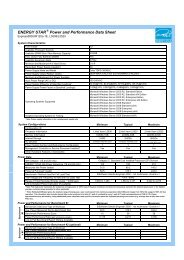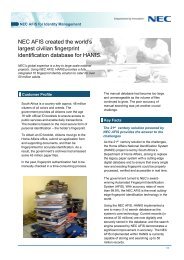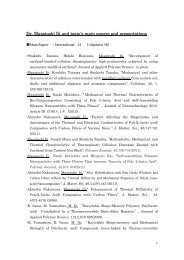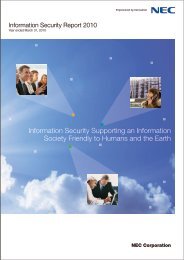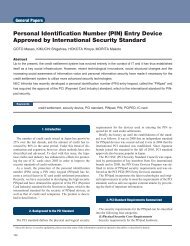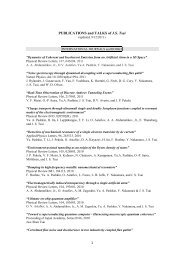Technologies Behind NEC's High Temperature Ambient Server
Technologies Behind NEC's High Temperature Ambient Server
Technologies Behind NEC's High Temperature Ambient Server
You also want an ePaper? Increase the reach of your titles
YUMPU automatically turns print PDFs into web optimized ePapers that Google loves.
<strong>Technologies</strong> <strong>Behind</strong> NEC’s <strong>High</strong> <strong>Temperature</strong> <strong>Ambient</strong> <strong>Server</strong><br />
5. Lineup<br />
The Express5800 series of x86 servers supporting ambient operating<br />
temperature of 40°C includes a wide variety of models such as a product<br />
for data center providers that use a large number of servers and a tower<br />
server ideal for offices, shops, and other smaller-scale applications.<br />
DataCenter Line DataStation Line<br />
8Way<br />
A1080a<br />
Eco-Friendly Data Center<br />
NEC has launched an Eco-Friendly Data Center project to promote power efficiency in<br />
data centers. The goal of this project is to implement power savings in facilities as a<br />
whole by reducing the power consumption of not only ICT equipment but also the<br />
cooling system and other equipment, as well as to promote eco-friendly data center<br />
construction and facilities management.<br />
The Eco-Friendly Data Center project supports data center power savings by providing<br />
consulting services, ICT equipment, and facilities solutions. The consulting services<br />
aim to visualize and highlight current problems in the data center from every viewpoint<br />
and propose measures to achieve appropriate goals. The ICT equipment comes in the<br />
form of the <strong>High</strong> <strong>Temperature</strong> <strong>Ambient</strong> Express5800 series, NEC Storage M series, and<br />
power saving control software applications. The facilities solutions involve facility<br />
monitoring and other solutions to improve cooling efficiency.<br />
Consulting services<br />
ICT equipment<br />
2Way<br />
E120d-M<br />
E120d-1<br />
R120d-2M<br />
R120d-1M<br />
R120d-2E<br />
R120d-1E<br />
T120d<br />
<strong>Server</strong> consolidation assessment<br />
IT environment assessment<br />
Start,Basic,Advance<br />
Construction assessment<br />
Power saving hardware<br />
Power saving control software<br />
(such as virtualization technology)<br />
1Way<br />
R110e-1E<br />
GT110e-S<br />
GT110e-S<br />
(Water-cooled)<br />
GT110e<br />
Facilities monitoring system<br />
Cooling <br />
system solution<br />
<strong>High</strong>ly-efficient backup solution<br />
Eco Cloth Jacket<br />
Facilities solutions<br />
HTA servers also useful for offices and shops<br />
Power saving is required in many locations other than data centers. Even without the order<br />
to limit the use of electricity issued by Japanese government in 2011, awareness has been<br />
high concerning the need to save power in offices and shops. The Express5800 series of<br />
x86 servers supporting ambient operating temperature of 40°C can be used to conserve<br />
power in these places.<br />
When servers whose maximum ambient operating temperature is 35°C are installed in an<br />
office, there is no choice but to set the cooling system to a lower temperature.<br />
Implementing a model supporting ambient operating temperature of 40°C allows you to<br />
set the cooling system to a higher temperature, significantly reducing power consumption.<br />
According to a document published by the Agency for Natural Resources and Energy of<br />
Japan, increasing the office temperature by 2°C reduces cooling system power<br />
consumption by approximately 8%.<br />
6. Conclusion<br />
This white paper describes a design concept developed by NEC to improve<br />
the cooling ef ficiency of HTA ser vers and storage devices, and<br />
demonstrates that cooling system power consumption, which accounts for<br />
approximately 30% of the power consumed in data centers, can be<br />
reduced by implementing these servers and storage devices. This white<br />
paper also provides examples of verifications tests confirming that stability<br />
can be maintained by only using a direct free air cooling method and that<br />
the servers and storage devices can operate for a long period of time even<br />
in a high temperature environment.<br />
Before<br />
35<br />
<strong>Server</strong>s become<br />
unstable unless the cooling<br />
system temperature<br />
setting is 20°C<br />
or lower...<br />
We need to<br />
implement<br />
power saving<br />
measures...<br />
After<br />
40<br />
Raising the cooling system<br />
temperature setting<br />
by 5°C saves power!<br />
As we shift to cloud computing, data centers are becoming increasingly<br />
important. The HTA servers and storage devices from NEC support<br />
enterprises who want to promote environmental friendliness in their data<br />
centers and IDC providers who want to provide high-quality, inexpensive<br />
data center services.<br />
Model that can operate<br />
at an ambient<br />
temperature of 40°C<br />
The maximum ambient operating<br />
temperature for servers is usually 35°C<br />
The server’s maximum ambient<br />
operating temperature is 40°C.<br />
Increasing the ambient temperature in the office by 2°C reduces<br />
cooling system power consumption by approximately 8%.<br />
*Quoted from a document published by the Agency for Natural Resources and Energy of Japan.<br />
(The average effect is calculated assuming maximum power usage on a day on which the temperature is 35°C or more.)<br />
<br />
<br />
<br />
<br />
© 2012 NEC Corporation The NEC logo is a registered trademark or a trademark of NEC Corporation in Japan and other countries.<br />
2012.9<br />
8


